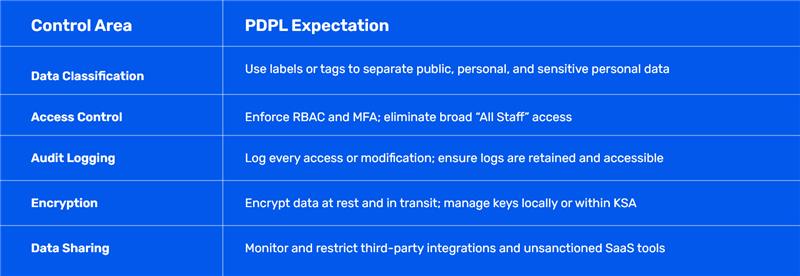Cloud data processing under Saudi Arabia's PDPL
Tak to usIntroduction
Saudi Arabia’s Personal Data Protection Law (PDPL) is fundamentally changing how cloud environments must be designed and governed. It is not a template borrowed from GDPR. It is a national mandate with specific requirements around consent, residency, and lawful data processing.
The PDPL governs every aspect of personal data handling, right from initial collection through processing, storage, and cross-border transfers. Most global architectures, by default, do not meet these standards. As regulatory enforcement becomes more stringent, any strategy that does not account for cloud data residency, lawful processing, or user rights will create significar compliance exposure.
Let’s take a look at what PDPL cloud data processing in Saudi Arabia really entails, and how organisations can align their cloud data privacy controls and architectures with the law’s evolving expectations.
What PDPL Expects from Cloud-Hosted Environments
Saudi Arabia’s PDPL introduces obligations that apply directly to cloud infrastructure, not just business processes. Any environment hosting personal data must demonstrate compliance with both technical and legal requirements defined by the Saudi Data and Artificial Intelligence Authority (SDAIA).
Core mandates include the following:
- Personal data must only be processed with clear, informed consent.
- Collection must serve a lawful, specified purpose.
- Individuals must retain the right to access, modify, or delete their data.
- Data breach notifications must follow the defined regulatory timeline.
Residency is central to the law. Hosting data inside Saudi Arabia is the default requirement, not a best practice. Exemptions are permitted but very tightly controlled. These require explicit user consent, a risk assessment of the destination country, and binding contracts with third parties handling the data.
Many public cloud configurations don’t meet these data residency requirements in Saudi Arabia. Logs, telemetry, backup copies, and admin dashboards often default to non-local regions. These indirect data flows are still in scope under PDPL.
Cross-border data transfers are not prohibited under PDPL, but they are heavily scrutinized. Businesses must justify the need to transfer data overseas, secure user
consent, and document safeguards in the destination country. Informal agreements, SLA clauses, or implied consent do not meet PDPL thresholds.
In regulated sectors, ignoring cloud compliance PDPL Saudi Arabia obligations is a violation with severe legal consequences.
Classifying and Securing Cloud Data Under PDPL
PDPL does not treat all data the same. It introduces specific expectations for how data is classified, accessed, and protected, especially in cloud-hosted environments.
The law distinguishes between public data, personal data, and sensitive personal data. Each requires a different level of control. Most organizations don’t struggle with encryption. They struggle with identifying what exactly needs to be encrypted, logged, or restricted.
Classification is not optional.

The first step is tagging or labeling cloud data based on sensitivity.
This can be enforced through platform-native tools or external policy engines. Classification must extend across storage, backups, and even data in transit.
Access control must be tied to roles. Broad access groups, especially those labeled “All Staff”, violate basic compliance principles. Role-based access control (RBAC) and multi-factor authentication are the minimum standard.
Data classification Saudi PDPL standards also require that all access, modification, or movement of personal data is logged. These logs must be retained and reviewable. Absence of audit trails is treated as non-compliance, not oversight.
Encryption must cover data at rest and in transit. But encryption alone is insufficient. Key management is part of the requirement. Keys must be stored within the organization or inside cloud data residency Saudi Arabia zones, not with third-party platforms. unless explicitly authorized.
Cloud environments also need active controls for data sharing. Unsanctioned third-party integrations, unmanaged SaaS connectors, or automated workflows can violate cloud data privacy Saudi Arabia expectations, even if data never leaves the cloud.
If classification is missing, every downstream control fails silently. PDPL assumes you know what kind of data you’re holding and can prove how you’re protecting it.
Operationalizing Cloud Compliance Under PDPL
Building a PDPL-compliant cloud environment requires more than technical controls. It demands alignment across architecture, documentation, and continuous monitoring. Each stage of the cloud lifecycle, i.e., design, deployment, and operations must enforce residency and governance by default.
1. Map Workloads and Data Dependencies
Before you migrate or scale cloud services, assess what personal data is involved, where it resides, and which services interac with it. Residency controls only work when upstream dependencies are known.
To meet data residency requirements Saudi Arabia, enterprises should:
- Identify workloads that process personal or sensitive personal data
- Confirm if any component, such as logs, backups, DR, etc., is hosted outside Saudi Arabia
- Review exemptions tied to cross-border data transfer Saudi PDPL provisions
- Tag and categorize data by sensitivity before applying protection measures.
2. Design with Residency and Documentation in Mind
Architecture alone doesn’t prove compliance. It must be backed by documentation that reflects cloud compliance PDPL Saudi Arabia expectations, including region selection, processor obligations, and breach timelines.
To ensure optimum enforceability:
- Choose cloud regions that meet cloud data residency Saudi Arabia standards
- Review telemetry and backup defaults, ensuring no silent outbound flows
- Execute DPAs and contracts that bind cloud vendors to PDPL obligations
- Document region choices and exemptions clearly in architecture records
Enforce Technical and Operational Controls
Tools must reinforce policy. These controls are expected under PDPL, not optional. Misconfigurations, broad entitlements, or missing audit trails all qualify as violations, regardless of the intent.
To ensure technical alignment with cloud data privacy Saudi Arabia standards:
- Enforce RBAC and MFA across all cloud access points
- Encrypt data at rest and in transit, with keys managed inside KSA
Log all data access, modification, and configuration events - Log all data access, modification, configuration events
- Continuously monitor workloads for misconfigurations or drift
- Restrict or review unsanctioned third-party connections and SaaS tools
PDPL expects that cloud compliance PDPL Saudi Arabia is not just planned but demonstrable. Controls, logs, contracts, and architectural decisions must align-across every point where personal data is created, moved, or stored. Without that visibility and validation, compliance cannot be claimed.
Build Compliance-First Cloud Architectures with Paramount
Most cloud architectures are built for uptime, not compliance. Under PDPL, that priority order must shift. Data residency, classification, access, and encryption are no longer internal policy decisions-they are legal obligations.
This is where working with the right partner makes all the difference.
Paramount has deep expertise in helping organizations navigate cloud compliance in regulated markets like the Kingdom of Saudi Arabia. From data classification frameworks and access control policies to cross-border transfer governance and cloud architecture reviews, Paramount helps you embed PDPL requirements into the foundation of your cloud operations-not just layer them on as an afterthought.
